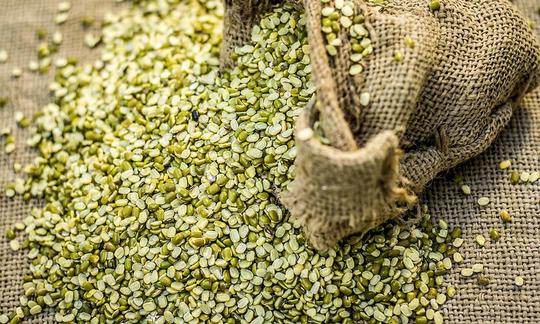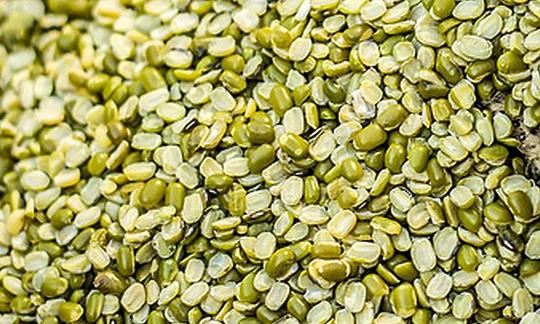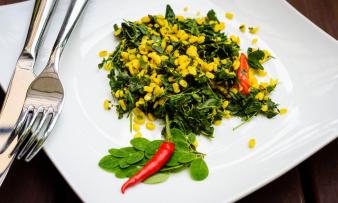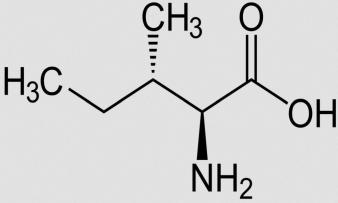Table of contents
Moong Dal is characterized by its excellent amino acid profile and is very popular in the preparation of hearty stews and curries. Organic quality?
Use in the kitchen
The term dal refers to dried pulses, such as lentils, chickpeas or peas, and the dish that can be prepared with them: a spicy, piquant stew or a hearty curry soup with a mushy consistency that originates from Indian and Pakistani cuisine. Moong Dal (Mung Daal) refers to the dried, halved mung beans .
What types of moong dal are there? Two types are used in cooking. On the one hand, there is moong dal with a shell, which makes it green on the outside. The second option is the peeled version. Due to the lack of a shell, this type is characterized by a yellow, sometimes white color. In addition, the peeled version shortens the cooking time and you can skip soaking. Peeled moong dal absorbs the flavor of spices particularly well. Both have the advantage over other pulses that they are easier to digest.
How do you prepare moong dal? Moong dal cannot be eaten raw because of the anti-nutrients it contains, but must be cooked before consumption. To do this, soak the unpeeled legumes for several hours or overnight. Then cook them for 20-30 minutes. Peeled moong dal does not need to be soaked, but can be cooked straight away, similar to red lentils . Before use, it is sufficient to rinse the dried mung beans carefully and cook them for 12-15 minutes. Moong dal is usually cooked until it is soft and creamy, but still has a certain structure and a pleasant fine bite. For a mushy consistency, you can cook it for longer with a little more water.
Moong Dal is very high in protein and is therefore particularly suitable for a vegetarian or vegan diet. It is very versatile to prepare and the ingredients can be varied as desired. This dal is often prepared with onions, ginger, garlic and various spices, including ground cumin, turmeric, curry powder, chili peppers ,pepper and garam masala . You can also add other pulses and vegetables, such as tomatoes, spinach, potatoes, chard and aubergines . For cooking, use water, vegetable stock, coconut milk or chopped tomatoes, depending on the desired consistency and taste. For a particularly creamy dal, you can refine it with soy yoghurt . Raw coriander leaves, pomegranate seeds and lemon juice go particularly well with the aromatic taste of the dal.
Moong Dal can also be used to create warming soups, such as the Indian spicy soup Rasam. It is served as a starter, refined with pureed Moong Dal. In addition to the classic spices, fenugreek, mung bean sprouts or cress, as well as nuts and seeds such as roasted pumpkin seeds and hemp seeds, are delicious as toppings. Soups that contain red lentils as an ingredient can be prepared with Moong Dal for more variety, as the cooking time and consistency are similar.
In Indian recipes, Moong Dal can be found in classic curries, in Khichdi, a stew with rice, in the fried dough balls Vadas and the thin crispy pancakes Dosas. Moong Dal is also used in powder form in traditional Indian desserts such as Laddu and Halva.
In addition to the classic Indian dishes and preparation variants, the pulses also taste good in Asian vegetable stir-fries. To do this, they are cooked until al dente and added together with vegetables such as spring onions, leeks, carrots, broccoli, shiitake mushrooms and Chinese cabbage, together to create a colorfully mixed stir-fry. Soy sauce and lime juice round off the whole thing in a tasty way.
Vegan recipe for Moong Dal with spinach
Ingredients (for 2 people): 200 g Moong Dal, 1 onion, 250 g fresh spinach (raw, organic), 2 cloves of garlic (organic), juice of half an organic lemon, 1 tbsp rapeseed oil, 200 ml coconut milk, 750 mL water, 1 tbsp finely chopped ginger (organic), 1 green chili pepper, 1 tsp ground cumin, 1 tsp ground turmeric, half a teaspoon ground coriander ,black pepper, salt, coriander leaves, pomegranate seeds, 1 tbsp soy yoghurt .
Preparation: Wash the halved mung beans with water and drain. Finely chop the onion, garlic, ginger and chilli pepper. Heat the rapeseed oil in a pan and sauté the onion until translucent. Then add the ginger and garlic. Wait a moment and then mix in the spices and the moong dal. Add coconut milk and water and simmer everything for about 20 minutes. Add more water if necessary. Finally, add the spinach and continue to simmer until the spinach collapses. Finally, refine with lemon juice and season with salt and pepper. Optionally, you can garnish the finished moong dal with a tablespoon of soy yoghurt, fresh coriander leaves and pomegranate seeds.
Vegan recipes with Moong Dal can be found under the note: " Recipes that have the most of this ingredient ".
| Not only vegans or vegetarians should read this: Vegans often eat unhealthily. Avoidable nutritional errors . |
Purchasing - Storage
Moong Dal is available all year round, mainly in Asian shops, exotic supermarkets, natural food stores, well-stocked health food stores and organic supermarkets such as Denn's Biomarkt and Alnatura . You can also buy the broken mung beans in online shops. Supermarket chains such as Coop, Migros, Denner, Volg, Spar, Rewe, Billa and Edeka, and discounters such as Aldi, Lidl or Hofer do not usually stock Moong Dal.
There are usually two versions available to buy: unpeeled (green) and peeled Moong Dal. If you find it under the name Moong Dal Chilka, the term Chilka refers to the peel and means the unpeeled version. It is often sold in stores under the name Mung Daal.
Conventional moong dal should be avoided because of the possible toxic treatment. It is therefore important to make sure that it is organically produced.
The availability of Moong Dal varies depending on the size of the store, catchment area, etc. Our recorded food prices for the DA-CH countries can be found above under the ingredient image - and by clicking you can see their development at various suppliers.
Storage tips
For optimal storage of dried, halved mung beans, we recommend dark, dry and cool conditions.
Ingredients - Nutritional Values - Calories
What nutritional values does Moong Dal have? Moong Dal has 312 kcal/100g. The macronutrients are divided into 59 g carbohydrates, 23 g protein and 1.2 g fat per 100 g. Moong Dal is therefore an excellent source of plant-based protein. Raw chickpeas (20 g/100g) and red lentils (24 g/100g) have similar values. The fiber content of 17 g covers 69.2% of the daily requirement.
Mung beans, like soybeans, goa beans and quinoa, are characterized by an excellent amino acid profile. The amino acid composition is particularly good because it contains all 8 essential amino acids. The tryptophan content is 1.2 g/100g and covers 470% of the daily requirement. The amino acid isoleucine is present at 1.9 g/100g, which corresponds to 152% of the daily requirement.
The high lysine content makes Moong Dal particularly valuable. 100 g contain 1.8 g of lysine (97% of the daily requirement). Grains such as wheat or rice have a low lysine concentration, which can be compensated for by eating Moong Dal. Lentils and broad beans have comparable lysine values of 1.7 g/100g.
Moong Dal is an excellent source of vitamin K. 100 g contain 130 µg, which is 173% of the daily requirement. Swiss chard (830 µg/100g) and fresh parsley (1640 µg/100g) have particularly high vitamin K contents.
The vitamin folate content is 140 µg/100g (70% of the daily requirement), similar values are found in kale (141-212 µg/100g) and spinach (194 µg/100g). Grains, legumes, brassicas and green leafy vegetables are very rich in folate. 1
The mung bean contains many secondary plant substances, including phenolic components such as phenolic acids, flavonoids and tannins. Studies show that mung beans also contain organic acids, sterols, triterpenes, aldehydes and lipids. 2
The complete ingredients of Moong Dal (raw), the coverage of the daily requirement and comparison values with other ingredients can be found in our nutrient tables. In the article Nutrients explained you will get a detailed insight into the topic.
Health Effects
It is worth noting that studies on health benefits usually examine the whole mung bean, but the results can also be applied to moong dal due to the similar nutrient composition.
Is Moong Dal healthy? Research suggests that mung beans have the ability to modulate or even prevent chronic degenerative diseases such as diabetes, cardiovascular disease, cancer and arthritis. 2 Studies have shown that the polyphenols, polysaccharides and polypeptides it contains have antioxidant properties that may help prevent disease. 3
This legume has a blood sugar lowering effect, which results from the low glycemic index of mung bean starch and the higher amylose content compared to other legumes. In laboratory and animal experiments, it was found that mung beans have an inhibitory effect on the enzymes α-amylase (pancreas) and α-glycosidase (intestine). This leads to a decrease in carbohydrate absorption in the intestine, an increase in insulin sensitivity and thus to a reduction in hyperglycemia in the body. The flavones vitexin and isovitexin (secondary plant substances) are considered to be important active components that regulate glucose metabolism. 3
The positive association between the consumption of mung beans and the regulation of lipid metabolism is illustrated by the legume's hypolipidemic effect. In addition, mung dal has been shown to act as an effective hepatoprotective agent by reducing the activities of liver enzymes in a dose-dependent manner. Cholesterol-lowering properties have been demonstrated in hamsters, which were further enhanced after germination. 6 These liver-protective effects are due to bioactive compounds, fiber, proteins and their specific amino acid composition, as well as bioactive peptides in mung beans. 3
Mung beans also have a proven blood pressure lowering effect. After a single oral administration of a hydrolysate of mung bean protein isolate at a dosage of 600 mg/kg body weight, a significant drop in blood pressure was observed in hypertensive rats. 4
The phenolic antioxidants in mung beans have the ability to reduce oxidative stress in vitro and in vivo . Depending on the dose, they can prevent the development of cancer and inhibit the growth of cancer cells. 5
In addition, these legumes are characterized by anti-inflammatory, antiviral, antifungal and antibacterial properties. 2
The cause of intestinal bloating after eating beans is the oligosaccharides they contain, such as raffinose, stachyose and verbascose. In contrast to red beans and lentils, moong dal has a lower stachyose content, which explains its easier digestibility. Fermentation can further reduce the bloating factor. 7
Dangers - Intolerances - Side effects
People who are allergic to birch pollen may experience allergic reactions when consuming Moong Dal. This reaction results from the structural similarity between the main allergen in birch pollen (Bet v 1) and the mung bean allergen (Vig r 1), which leads to cross-reactivity. 8
Mung beans contain antinutrients such as phytic acid. Phytic acid binds to important divalent cations such as iron, zinc, calcium or magnesium, forming insoluble complexes. This results in limited mineral absorption and utilization in the small intestine. You can find out more about this in the article on phytic acid or phytate and soaking or sprouting . Other nutritionally inhibiting factors that inhibit the bioavailability of minerals are tannins, hemagglutinin and trypsin inhibitors. Fermenting, sprouting, peeling and cooking minimize the antinutrient content and thus ensure better bioavailability. 3,9 Mung beans should therefore be soaked and cooked before consumption.
Beans are usually not edible raw because they contain the lectin phasin, which is dangerous for humans. By heating and cooking them sufficiently, phasin can be rendered harmless and thus the potential danger eliminated. 10 We do not have any information on the occurrence of phasin in mung beans. Nevertheless, it is advisable to cook mung beans before consumption, especially because of their mentioned antinutrients.
Folk medicine - natural medicine
According to traditional Chinese medicine ( TCM ), mung beans help to eliminate heat in the body and reduce swelling in summer. This legume has a detoxifying effect as it rids the body of toxins. In folk medicine, it is therefore used to treat acne, eczema, dermatitis and to relieve itching.
Ecological footprint - animal welfare
The selection of previous crops (pre-crops) plays a crucial role in optimizing energy efficiency, sustainability and minimizing environmental impact in mung bean production. A study in Iran compared the carbon footprint of mung beans grown after wheat, rapeseed and barley as pre-crops. The results showed a carbon footprint of 1.05 kg CO 2 eq/kg (wheat), 1.22 kg CO 2 eq/kg (rapeseed) and 1.11 kg CO 2 eq/kg (barley), respectively. The study concludes that wheat is more sustainable as a pre-crop compared to barley and rapeseed when considering the amount of mung beans produced in kg. 12
For comparison, greenhouse gas emissions in Europe and America are 0.38-1.3 kg CO 2 eq/kg for soybeans and 0.68 kg CO 2 eq/kg for brown beans. The values for green beans are 0.94 kg CO 2 eq/kg and for peas 0.49 kg CO 2 eq/kg. Although the ecological footprint of mung beans is slightly higher in Iran than in Europe and America due to lower legume yields per hectare, the values are still comparable. 12
If you compare legumes with meat products, they produce a significantly lower amount of greenhouse gases. Minced beef (organic) has a value of 15.1 kg CO 2 eq/kg. 13
To determine the water footprint, a study examined 10 crops in different regions of Thailand, including 2 types of rice, corn, soybeans, mung beans, peanuts, cassava, sugar cane, pineapple and oil palm. Compared to the other crops, the mung bean had the highest water footprint with an average of 2980 l/kg. The values varied depending on the region between 1549 and 6445 l/kg during the dry season. During the rainy season, this bean did not require any additional water. 15 In Ethiopia, another study determined a water footprint of 6561 l/kg, which is similar to the highest value in the Thai study. 16
The results show that the variations in water requirements of mung bean in different regions are the result of numerous factors. The differences between the two studies can be attributed to different crop species, growth cycles, soil parameters, geographical differences in water availability, climatic conditions and other influencing factors. Although mung bean requires more irrigation water per tonne of product than other agricultural crops such as rice, cassava and sugarcane, it also requires smaller areas of cultivation. This reduces its overall contribution to water competition compared to other major crop species. 15
In comparison, the water footprint of vegetables is 300 l/kg and grains have a value of 1600 l/kg. Spices have a particularly high water requirement of around 7000 l/kg. 11
It should be noted that the ecological footprint and water footprint values refer to mung beans, as there is no separate data for Moong Dal.
Legumes, including mung beans, serve an important function in many ecosystems and agricultural soils through green manure. They enrich the soil with nitrogen through symbiosis with nodule bacteria. The bacteria fix the nitrogen from the air and make it available to the plants. Due to this symbiosis, mung beans require only minimal amounts of nitrogen to grow, or even no nitrogen at all. Green manure enables mung beans to be grown without the use of environmentally harmful nitrogen fertilizers. 12,14
It is recommended to avoid conventional mung beans due to potentially toxic treatment. Instead, choose organically farmed mung beans to prevent pesticide damage to air, water, soil, forests and other environmental aspects.
Worldwide occurrence - cultivation
Around 3,500 years ago, farmers in India began to cultivate mung beans ( Vigna radiata L.) and to expand the cultivation of the legume on a large scale. This type of bean then spread from India to China and various regions of Southeast Asia. 2 Currently, cultivation extends over more than 6 million hectares worldwide, which corresponds to around 8.5% of the global legume area. The mung bean is widespread in many Asian households, which is why it is primarily grown in China, India, Bangladesh and Pakistan. However, it can now also be found in dry regions of southern Europe, in warmer parts of Canada and the USA. 3
Cultivation - Harvest
The mung bean is an annual plant and thrives best in warmer climates with temperatures of 20-35 °C. With a growth height of up to 90 cm, growing the climbing plant requires little effort. It shows impressive adaptability and thrives in different soil types. With a growth cycle of 75 to 90 days, it is very short-lived. 2 Another advantage is that legumes (fabulae) are able to bind atmospheric nitrogen in the soil, which makes them ideal for the summer fallow period in the predominantly rice and wheat-based agriculture of the Ganges Plain in India. 17
The three-leafed, alternately arranged green leaves give the mung bean a characteristic appearance. Mung bean plants are characterized by green to light yellow flowers. The fruits, which are up to 12 cm long and hang downwards, are called pods. From a botanical point of view, they are not pods. Each pod contains 10-15 ellipsoid seeds, the color of which ranges from green to yellow to brown or black speckled. 2
Further information
The mung bean belongs to the legume family (Fabaceae) and the subfamily of the Faboideae. Other representatives are soybeans, borlotti beans, kidney beans, black beans, white beans, lentils and many more.
There are over 200 different types of mung beans, which are divided into 3 varieties: The best-known variety is the green mung bean Vigna radiata var. typica, which is also known in English-speaking countries as "green gram". Vigna radiata var. aurea are the yellow mung beans, also called "golden gram". The third variety Vigna radiata var. grandis is characterized by its black seeds.
Moong Dal can be confused with other pulses such as yellow peas, lentils or chickpeas due to its similar appearance. To identify it accurately, it helps to pay attention to the differences in size, texture and color differences.
Alternative names
Moong Dal is also known as Mung Daal. Other names are Mungo Dal or Mungo Dal Lentils. In English they are called green gram dal, green moong dal, split green gram or mung lentils.











Comments